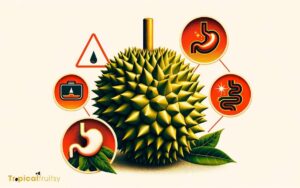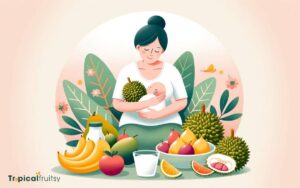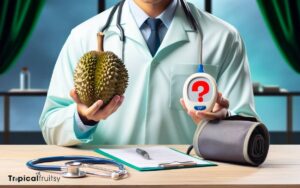Can You Eat Durian Seeds? Discover the Surprising Truth!
Durian seeds are generally not recommended for consumption because they contain cyclopropene fatty acids, which can be harmful if ingested.
However, in some cultures, durian seeds are roasted, boiled, or fried to reduce potential toxicity and are consumed as a snack. It is crucial to process the seeds properly before eating to avoid health risks.
The edibility of durian seeds is a topic of debate due to the presence of potentially toxic substances.
Here’s a brief overview:
- Raw durian seeds are potentially toxic.
- Proper processing (e.g., roasting, boiling) can reduce the toxicity.
- Consumption practices vary across different cultures.
Safe consumption of durian seeds requires:
- Adequate preparation (heat treatment)
- Knowledge of risks
- Moderation in consumption
Exploring durian seeds as a food source should be approached with caution and knowledge of proper preparation techniques.
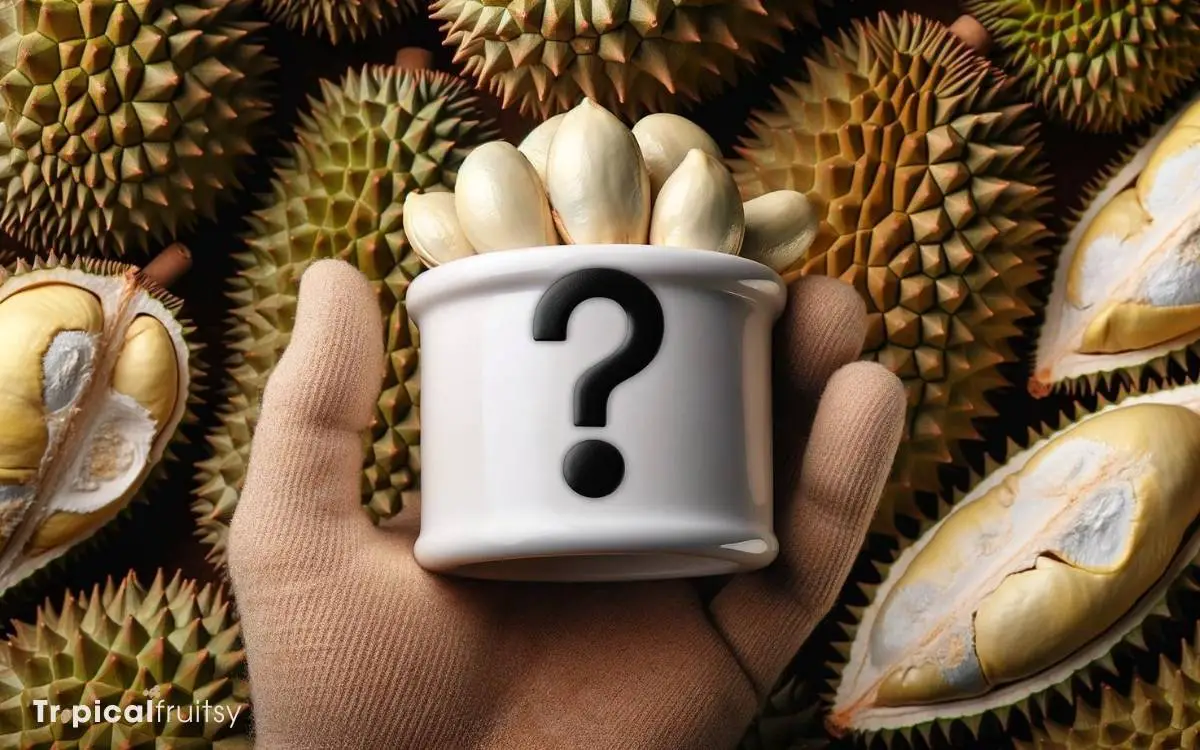
Key Takeaway
The Safety of Eating Durian Seeds: Preparation and Risks
| Preparation Method | Description | Cultural Context | Potential Risks |
|---|---|---|---|
| Roasting | Seeds are roasted until cooked | Southeast Asia | Reduces toxicity |
| Boiling | Seeds are boiled for several hours | Southeast Asia | Minimizes harmful compounds |
| Frying | Seeds are deep-fried until crispy | Southeast Asia | Decreases harmful effects |
Understanding Durian Seeds
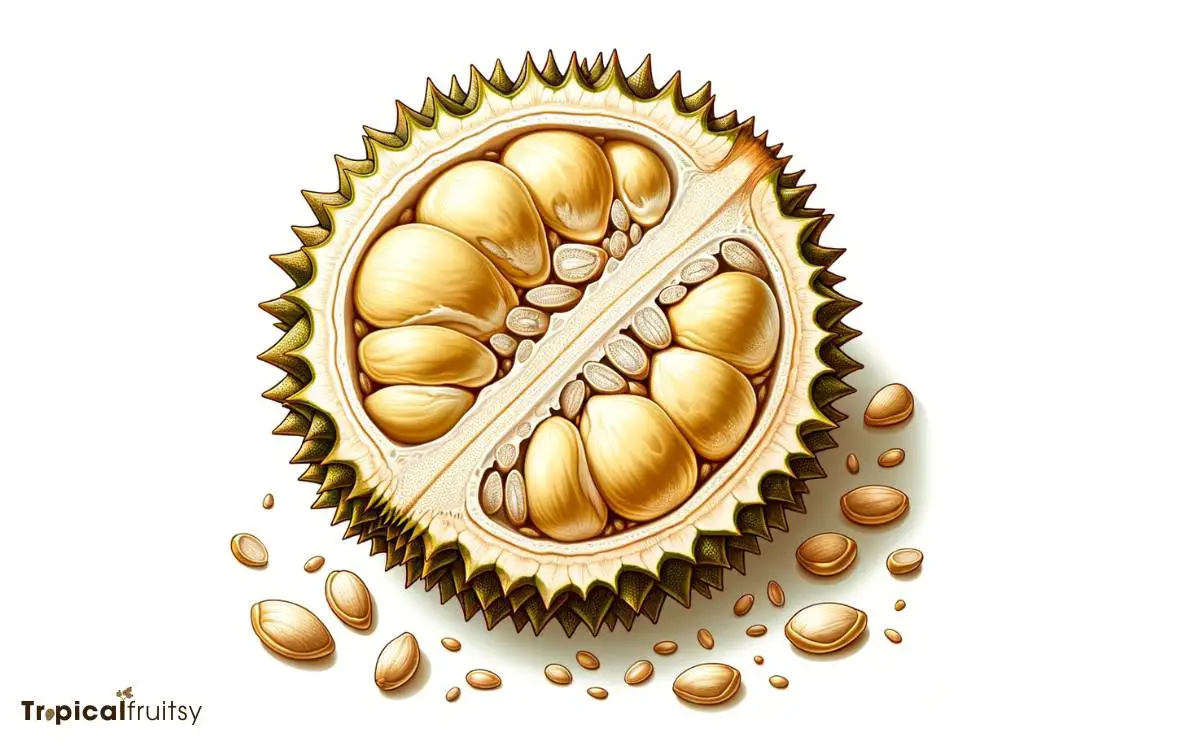
Durian seeds, encased within the fruit’s formidable husk, are large, oval-shaped kernels that are often overlooked in discussions of this controversially fragrant fruit.
Typically discarded or ignored, these seeds contain a variety of compounds, some of which have sparked interest in the scientific community for their potential nutritional and medicinal properties.
Structurally, they are composed of a hard outer shell and a dense inner kernel. Biochemically, they are rich in carbohydrates, proteins, and fats, which suggest a high caloric content.
However, their edibility and safety for human consumption remain subjects of debate. Detailed analysis and understanding of their chemical composition are crucial in assessing their viability as a food source.
Potential Health Risks
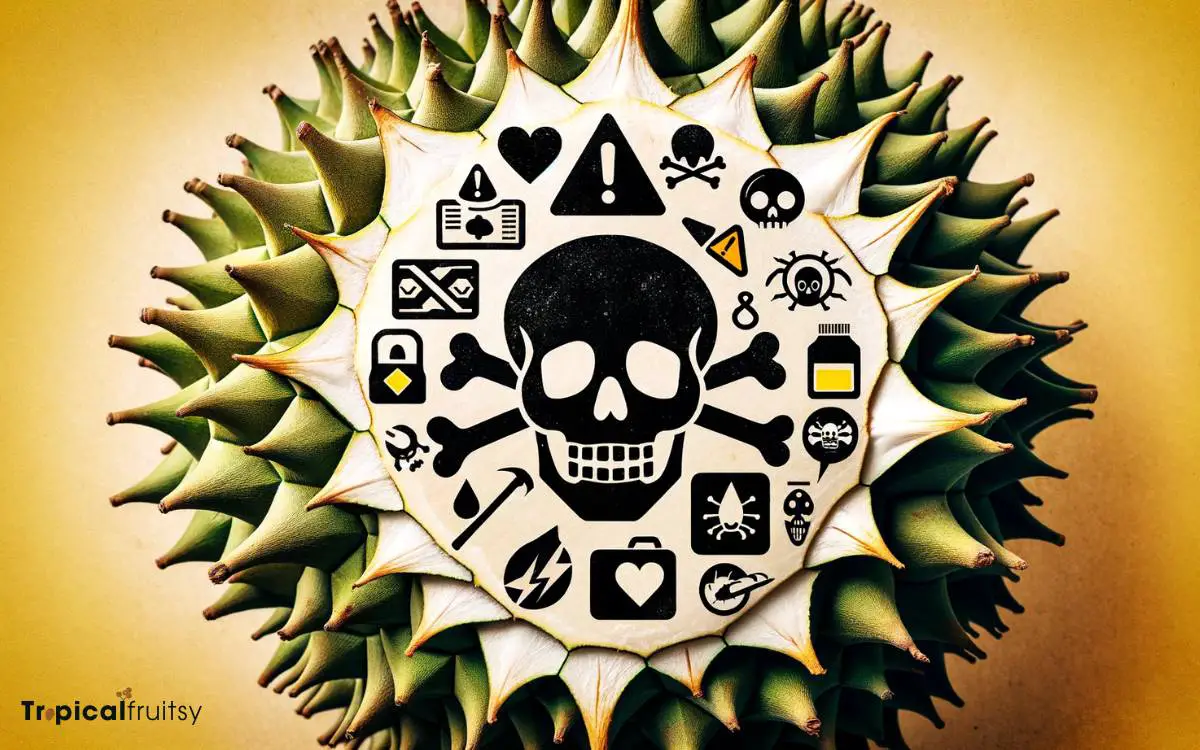
We must exercise caution when considering durian seeds as a food source due to the potential health risks associated with consuming them in their raw or improperly prepared state.
Scientific scrutiny reveals that these risks could be significant:
- Cyanide Toxicity: Unprocessed seeds contain cyanogenic glycosides, which can release toxic hydrogen cyanide upon ingestion.
- Digestive Obstructions: The large, hard seeds pose a risk for gastrointestinal blockages if swallowed.
- Allergic Reactions: Individuals may experience adverse immunological responses to compounds present in the seeds.
- Nutrient Malabsorption: Anti-nutrients in durian seeds may interfere with the digestion and absorption of essential nutrients.
Understanding the full implications of these hazards is crucial for anyone considering the consumption of durian seeds.
Nutritional Composition
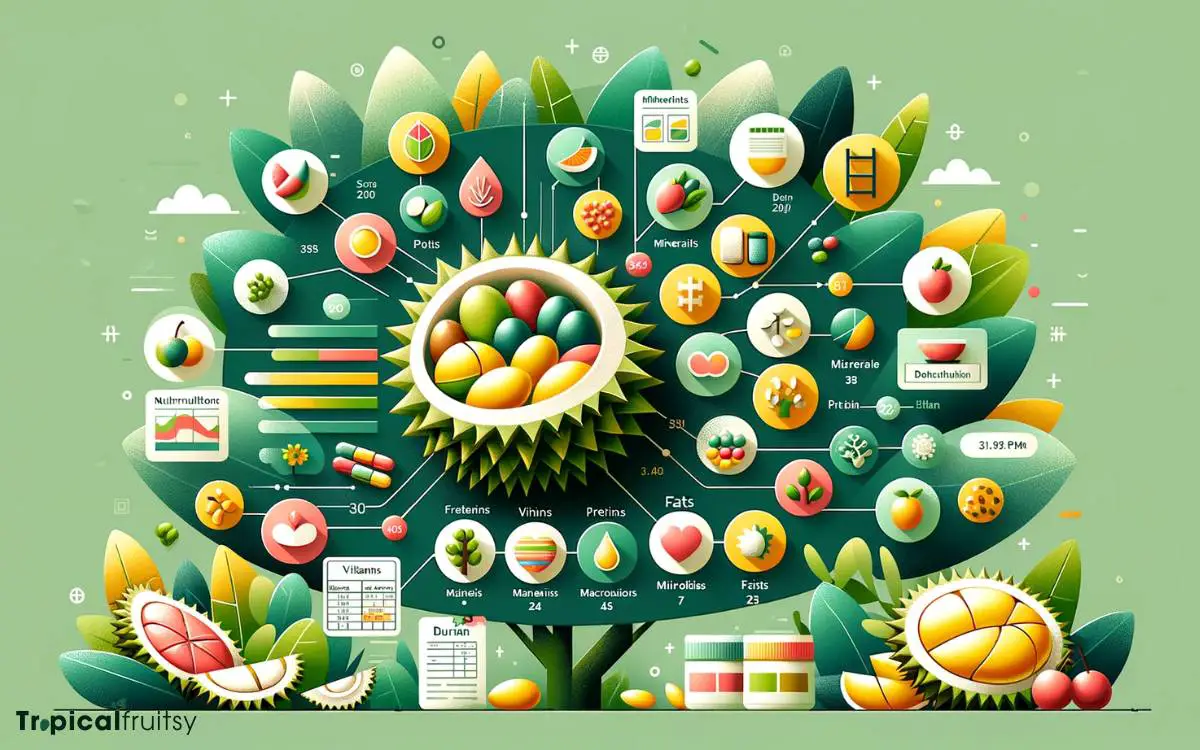
The nutritional composition of durian seeds is characterized by a specific macronutrient breakdown, which is essential for understanding their potential role in a diet.
Analysis of the seeds’ content reveals a quantifiable presence of vitamins and minerals, contributing to their micronutrient profile.
Considering the caloric content is also crucial, as it determines the energy value of the seeds when consumed.
Macronutrient Breakdown
Understanding the macronutrient profile of durian seeds is essential for evaluating their potential as an edible component of the fruit.
An analytical examination of their nutritional composition reveals a complex array of macronutrients that could influence both health and culinary applications.
The profile typically includes:
- Carbohydrates: A notable amount of starch, necessary for energy provision.
- Proteins: Essential amino acids present, albeit in limited quantities.
- Fats: Composed primarily of unsaturated fatty acids, which contribute to cardiovascular health.
- Dietary Fiber: Beneficial for digestive health, though the exact content may vary.
For an audience seeking insight, this breakdown suggests that durian seeds, if properly processed, might offer more than just caloric sustenance.
Their macro composition underscores a potential to enrich diets, contingent upon further safety and preparation research.
Vitamins and Minerals
Beyond their macronutrient content, durian seeds are also a source of several essential vitamins and minerals that are vital for maintaining good health.
The seeds contain B vitamins, particularly thiamine (B1) and riboflavin (B2), which are crucial for energy metabolism and maintaining proper nerve function.
Additionally, they are endowed with a variety of minerals including potassium, which is important for fluid balance and nerve transmission, as well as magnesium, known for its role in muscle function and bone health.
The presence of iron in durian seeds supports the production of red blood cells and prevents anemia.
However, data on the exact quantitative nutritional composition is limited, and further empirical research is needed to detail the specific concentrations of these micronutrients within durian seeds.
Caloric Content
We must consider the caloric content of durian seeds as part of their overall nutritional composition when evaluating their suitability for consumption.
The caloric density of a food item is a critical factor, particularly for individuals monitoring their energy intake for weight management or dietary purposes.
Durian seeds, akin to other seeds and nuts, are expected to have a high caloric content due to their macronutrient profile, which typically includes a significant amount of fats alongside proteins and carbohydrates.
- High caloric density – may lead to weight gain if consumed in large quantities.
- Energy-rich – beneficial for people requiring increased caloric intake.
- Potential for overconsumption – due to the satisfying nature of fatty foods.
- Nutrient-to-calorie ratio – important to evaluate for balanced dietary planning.
Analyzing the specific caloric content of durian seeds requires precise measurement, as caloric values can vary based on seed size and preparation method.
Preparing Seeds for Consumption
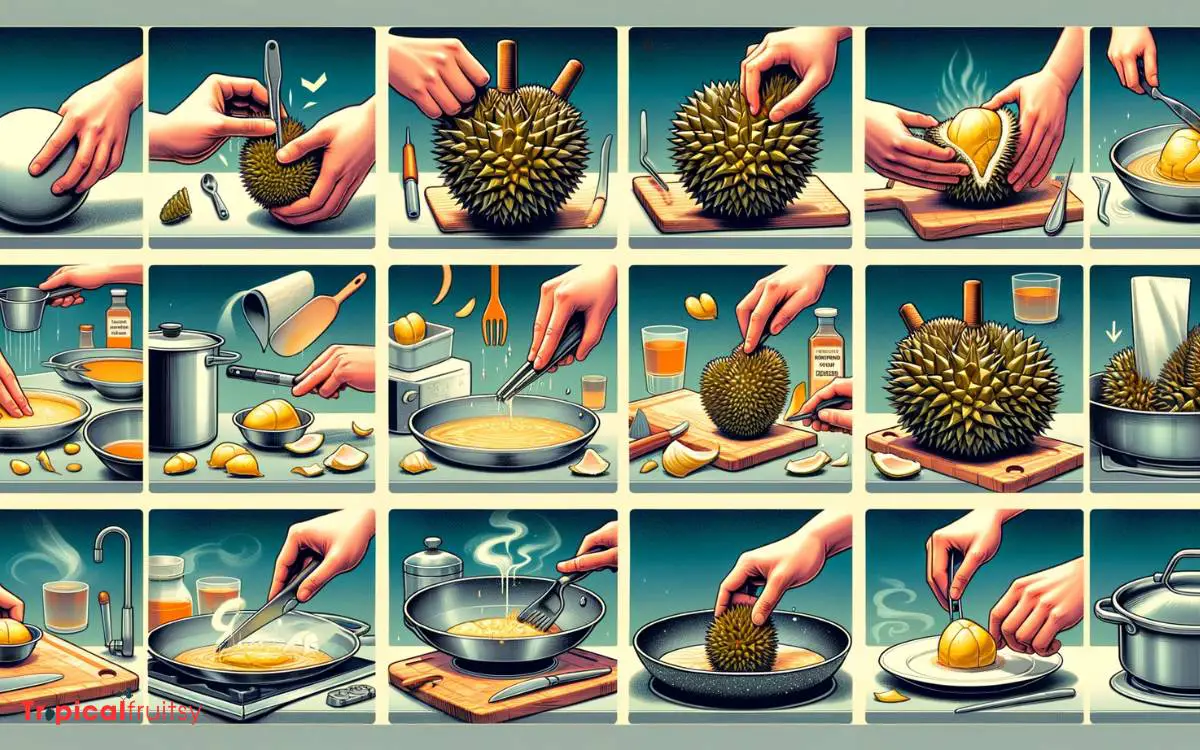
Prior to consumption, durian seeds require specific preparation methods to mitigate potential health risks associated with their raw state.
Thermal processing, such as boiling or roasting, has been shown to reduce or eliminate the presence of toxic compounds within the seeds.
It is imperative to examine the efficacy of these cooking methods in neutralizing toxicity while also considering the impact on the seeds’ nutritional value.
Cooking Methods
Several cooking methods can render durian seeds edible, each requiring specific preparation techniques to ensure safety and palatability.
These methods are designed to deactivate any potentially harmful compounds and to soften the seeds’ texture, making them suitable for consumption.
A meticulous approach is crucial, as improper preparation can result in an unpleasant culinary experience or health risks.
- Boiling: Immersing seeds in water for a prolonged period to eliminate antinutritional factors.
- Roasting: Applying dry heat to enhance flavor while ensuring the breakdown of tough fibers.
- Baking: A gentle, even cooking method that preserves nutrients while ensuring edibility.
- Frying: Quick exposure to high temperatures may create a crispy texture, but requires careful attention to prevent harmful compound formation.
Each technique must be executed with precision, following guidelines that prioritize the removal of inedible components and the enhancement of the seeds’ natural, nutty flavor profile.
Seed Toxicity Concerns
One must exercise caution when preparing durian seeds for consumption due to potential toxicity from compounds that may remain if not properly processed.
These seeds contain cyclopropene fatty acids, which can be harmful if ingested in large quantities.
The process of detoxification typically involves thorough cooking, which alters the chemical structure of these compounds, reducing their toxicity.
However, the efficacy of this process can be variable and is contingent upon factors such as duration of heat application and cooking method.
It is paramount to adhere to established guidelines for preparing these seeds to ensure that any residual toxins are neutralized.
Failure to do so may result in adverse health effects, underscoring the importance of meticulous preparation prior to consumption.
Cultural Practices and Beliefs

Throughout history, various cultures in Southeast Asia have held durian seeds in different regards, with some incorporating them into traditional dishes while others caution against their consumption due to potential toxicity.
This dichotomy highlights the intersection of culinary tradition and food safety, an area ripe for scientific exploration and cultural understanding.
- Reverence: In certain communities, durian seeds are cherished for their versatility and historical place in local cuisine.
- Caution: Tales of illness serve as somber reminders of the seeds’ potential danger when not treated correctly.
- Curiosity: The exotic nature of durians often inspires culinary experimentation, sometimes involving seeds.
- Tradition: Recipes passed down through generations may include methods of preparing durian seeds safely, signifying respect for ancestral knowledge.
An analytical examination of these practices necessitates an evidence-based approach, emphasizing the importance of understanding the balance between cultural heritage and health implications.
Safe Consumption Guidelines
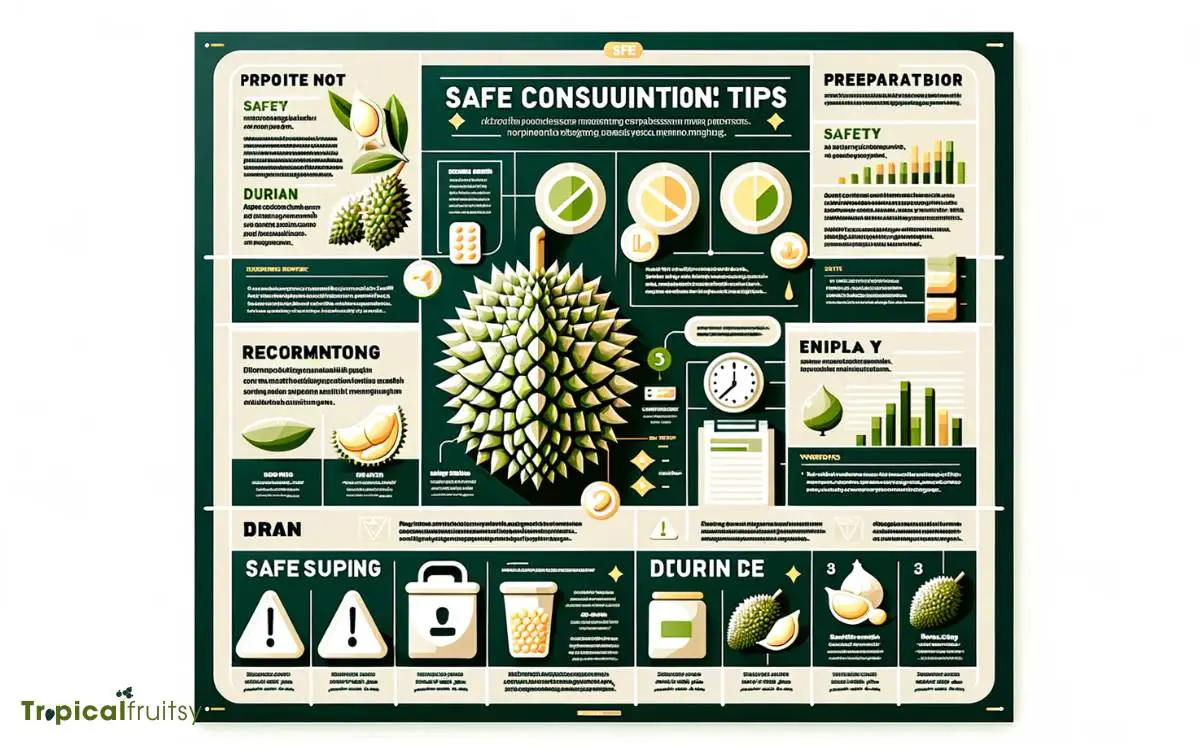
We must now turn our attention to the guidelines for safe consumption of durian seeds, which are critical to mitigate the risks associated with their potential toxicity.
Consuming raw or improperly prepared durian seeds is hazardous due to the presence of cyclopropene fatty acids, which have been linked to various health issues.
To neutralize these compounds, seeds must undergo thorough cooking. Boiling or roasting at high temperatures for a sufficient duration is necessary to degrade the toxic elements.
Current research suggests that these preparation methods can effectively reduce the levels of harmful substances, rendering the seeds safer for consumption.
However, empirical data is limited, and thus, the consumption of durian seeds, even when cooked, should be approached with caution and in moderation.
Conclusion
Durian seeds, often overshadowed by the fruit’s formidable aroma, harbor a universe of culinary potential when approached with caution.
Though they are not commonly consumed due to potential health risks and a complex preparation process, these kernels of intrigue pack a nutritional punch.
Embedded within cultural fabric, these enigmatic seeds beckon the brave, offering a gastronomic quest for those yearning to unlock their secrets, always under the vigilant guidelines of safe consumption.


